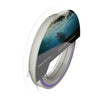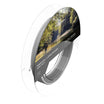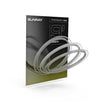Fly fishing for Grayling
We’re well into the traditional grayling season now & the trout are spawning. For some folks fly fishing for pike is their thing for the winter but for me grayling are far & away my favourite fish. I am lucky to live in easy reach of a wide variety of grayling waters; Driffield Beck chalk stream is on my doorstep, the small streams on the southern edge of the North Yorkshire Moors are less than an hour distant, whilst the industrial rivers of South Yorkshire & the Dales rivers are only an hour & a half to two hours distant.
Sadly all is not perfect: Driffield Beck no longer holds the vast shoals of quality grayling that were there in the 1960s, but each season it does produce a few huge fish, whilst Pickering Beck, the River Rye, the Yorkshire Derwent & the Dales’ rivers also hold depleted stocks. Cormorant predation is undoubtedly the main factor in the decline of these waters. The saddest story is that of Oxfolds/Costa Beck, once one of the country’s premier limestone spring fed grayling streams, which has totally collapsed as a grayling & trout fishery due primarily to pollution from two trout farms & a sewage outfall. Fortunately the industrial rivers have not suffered as much from cormorant activity & they now do not suffer from the severe pollution from industry that used to render them fishless.
Even in winter, when possible, I prefer to fish the dry fly, just because I love seeing the take & even last week (mid November) I was catching grayling from the Hampshire Avon on dry flies, casting to rising fish that were feeding on tiny midges & the occasional small Olive dun the was emerging. I find that grayling are far fussier than trout about good dry fly presentation; even a trace of micro-drag can put them off. Furthermore they tend to be loath to move more than a few centimetres off line to take a dry fly so casting must be pinpoint accurate & the fly must be landed a little further above a rising fish than would be normal with a trout since grayling generally rise from the riverbed, dropping back, downstream to take a fly.
I also find that in winter they respond best to tiny flies, size 24 CdC Midges & size 20 Shuttlecocks being my usual choice. Midges, in particular are of interest since they can be seen every month of the year, even on frosty winters days. If grayling are in a rising mood there tends to be flurries of activity interspersed with spells when not a single fish rises. I usually find that it is pointless covering fish that have temporarily stopped rising since at such times they rarely rise to my fly & all I end up doing is spooking the fish. Even changing to a nymph is rarely effective during these gaps in feeding activity. I just stand & wait for the next feeding spell. It was using these tactics that put me in the top three places on the R. Ure Salmon & Trout Conservation Grayling Day in November 2016.
Although I prefer the dry fly there are many times, particularly in the depth of winter, when the only logical option is to fish with subsurface flies. In the warmer water of November & in late February & March when there are hatches of Large Dark Olives they will often be prepared to come up for an unweighted nymph or Spider, but generally I find that I need relatively heavily weighted flies fished near to the river bed. In an earlier blog I told you of my five favourite grayling flies (Orange & Pink Shrimps, Orange & Pink Utah Killer Bugs, Red & Pink Squirmy Worms, Bead-head Partridge & Hare’s Ear Spiders & small Bead-head Nymphs). I also gave details of my favourite style of fishing subsurface (sight fishing) in another earlier blog, so I won’t go into detail about either of these subjects. What I will tell you about is my choice of setup for winter grayling.
Over the last few years I’ve been experimenting to find the perfect compromise setup for fishing dry fly or nymphs/bugs during winter. I started using a Carp Shock Leader kindly given to me by Stuart Wardle of the Durham Fly Fishing Company teamed up with a curly, bicoloured indicator & tippet about 1.5x the water depth. It worked well for French/Euro/Czech Nymphing & was adequate for dry fly (particularly with the indicator removed).
It had two disadvantages, firstly it was rather stiff & had quite a bit of coil memory after being on the reel (improved by boiling, then stretching) & secondly casting a dry fly wasn’t very accurate. Since then I’ve tried lighter Carp Shock Leaders (much cheaper than a commercially made French Leader) & several types of French Leader. All worked very well for Euro Nymphing, particularly the light Carp Shock Leaders & light French Leaders that could easily be held up, off the water, to control drag & maintain good contact with the flies, but they were far less effective when fishing with a dry fly. I have finally found a setup that works for me.
- It is a 0.55mm diameter Sunray Nymph line to which I have attached 7’ cut from an Essential Fly 12’ 5x tapered copolymer leader (tapering from 0.5mm to about 0.2mm) at the end of which I have tied a small perfection loop.
- If I am nymphing I connect a 15” bicoloured semi-curly indicator (loop to loop) to the end of the taper & then add 1.5x the water depth of 0.13mm tippet.
- If I am dry fly fishing I remove the indicator & when fishing tiny CdC Midges I add a section of 0.10mm tippet to the 0.13mm tippet.
- In windy conditions I may shorten the 0.13mm tippet section to aid turn-over & accuracy.
- With tiny dry flies I often attach them to the tippet with a Rapala Loop Knot to allow more freedom of movement of the fly, reducing micro-drag.
- The Micro Nymph line has zero memory, casts remarkably well with my 10’ 2 weight, 11’ 3 Weight & 12’ 3 weight rods & is easier to handle than a monofilament line, whilst the tapered section holds well off the water at short range & facilitates good turn-over & accuracy when fishing with a dry fly.
I have even found myself using this setup more & more during the summer for trout when I want a super-delicate presentation of a dry fly at short & medium range. I also often use it on my local small still water for fishing dry fly & very small buzzers.
I should add that I usually fish just a single fly, partly because it is the rule on my two closest waters, but also because in the past I have lost good fish due to double hookups or because a trailing fly has caught on a snag. I hate leaving a hook in a fish, even barbless hooks!
My alternative to this is to fish Tenkara as described in an earlier Blog.
Hampshire Avon grayling caught in mid November 2017 on a size 24 CdC IOBO Humpy & my winter grayling setup minus indicator.
































